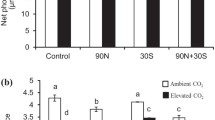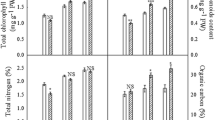Abstract
Seedlings of European white birch (Betula pendula Roth) were grown in growth chambers for one growth season under four carbon dioxide regimes (350, 700, 1050 and 1400 ppm) and at three fertilization levels (0, 100 and 500 kg ha−1 monthly). The soluble carbohydrates and secondary phenolics in the leaves and stems were analysed. It was found that fertilizer addition reduced the amounts of glucose and fructose while sucrose remained almost unaffected. The sugar content of leaves increased at 700 ppm and 1050 ppm of CO2 and decreased at the highest CO2 concentration (1400 ppm). The amounts of proanthocyanidins and flavonoids in leaves decreased with fertilization addition and increased with CO2 enrichment. The production of simple phenolic glucosides varied according to the fertilization and CO2 treatments. The triterpenoid content of stems seemed to increase with fertilization and CO2-addition. Our results indicate that the production of phytochemicals in the birch seedlings is very sensitive to both fertilization and CO2 addition, which is in agreement with earlier studies, and thus provide some support for the hypothesis of carbon allocation to plant defence when there is an excess of carbon and nutrient. The considerable variation in the production of secondary components may indicate that the synthesis of these defensive metabolites can be regulated by a plant to certain extent, depending on the ability of the plant to acclimate to changes in the physical environment.
Similar content being viewed by others
References
Balsberg Påhlsson A-M (1992) Influence of nitrogen fertilization on minerals, carbohydrates, amino acids and phenolic compounds in beech (Fagus sylvatica L.) leaves. Tree Physiol 10: 93–100
Billings WD, Peterson KM, Luken JO, Mortensen DA (1984) Interaction of increasing atmospheric carbon dioxide and soil nitrogen on the carbon balance of tundra microcosms. Oecologia 65: 26–29
Brown KR (1991) Carbon dioxide enrichment accelerates the decline in nutrient status and relative growth rate ofPopulus tremuloides Michx. seedlings. Tree Physiology 8: 161–173
Bryant JP (1987) Feltleaf willow-snowshoe hare interactions: plant carbon/nutrient balance and floodplain succession. Ecology 68: 1319–1327
Bryant JP, Chapin FS III, Klein DR (1983) Carbon/nutrient balance of boreal plants in relation to vertebrate herbivory. Oikos 40: 357–368
Bryant JP, Clausen TP, Reichardt PM, McCarthy MC, Werner RA (1987a) Effect of nitrogen fertilization upon the secondary chemistry and nutritional value of quaking aspen (Populus tremuloides Michx.) leaves for the large aspen tortrix (Choristoneura conflictana (Walker)). Oecologia 73: 513–517
Bryant JP, Chapin FS III, Reichardt PB, Clausen TP (1987b) Response of winter chemical defense in Alaska paper birch and green alder to manipulation of plant carbon/nutrient balance. Oecologia 72: 510–514
Bryant JP, Kuropat PJ, Reichardt PB, Clausen TP (1991) Controls over the allocation of resources by woody plants to chemical antiherbivore defence. In: Palo RT, Robbins CT (eds) Plant defences against mammalian herbivory. CRC Press, Boca Raton, pp 84–102
Cave G, Tolley LC, Strain BR (1981) Effect of carbon dioxide enrichment on chlorophyll content, starch content and starch grain structure inTrifolium subterraneum leaves. Physiol Plant 51: 171–174
Chu CC, Coleman JS, Mooney HA (1992) Controls of biomass partitioning between roots and shoots: Atmospheric CO2 enrichment and the acquisition and allocation of carbon and nitrogen in wild radish. Oecologia 89: 580–587
Farrar JF, Williams ML (1991) The effects of increased atmospheric carbon dioxide and temperature on carbon partitioning, source-sink relations and respiration. Plant, Cell Environ 14: 819–830
Harborne JB (1982) Introduction to ecological biochemistry. Academic Press, London
Julkunen-Tiitto R (1989) Distribution of certain phenolics inSalix species (Salicaceae). (Publications in Sciences, vol 15). University of Joensuu, Joensuu
Julkunen-Tiitto R, Meier B (1992) Variation in growth and secondary phenolics among field-cultivated clones ofSalix myrsinifolia. Planta Medica 58: 77–80
Julkunen-Tiitto R, Tahvanainen J, Silvola J (1993) Increased CO2 and nutrient status changes affect phytomass and the production of plant defensive secondary chemicals inSalix myrsinifolia (Salisb.). Oecologia 95: 495–498
Kramer PJ, Kozlowski TT (1979) Physiology of woody plants. Academic Press, London, pp 302–333
Larigauderie A, Hilbert DW, Oechel WC (1988) Effect of CO2 enrichment and nitrogen availability on resource acquisition and resource allocation in a grass,Bromus mollis. Oecologia 77: 544–549
Larsson S, Wiren A, Ericsson T, Lundgren L (1986) Effects of light and nutrient stress on defensive chemistry and susceptability toGalerucella lineola (Col, Chrysomelidae) in twoSalix species. Oikos 47: 205–210
Lincoln DE, Couvet D (1989) The effect of carbon supply on allocation to allelochemicals and caterpillar consumption of peppermint. Oecologia 78: 112–114
Lincoln DE, Couvet D, Sionit N (1986) Response of an insect herbivore to host plants grown in carbon dioxide enriched atmospheres. Oecologia 69: 556–560
Lindroth RL, Kinney KK, Platz CL (1993) Responses of deciduous trees to elevated atmospheric CO2: Productivity, phytochemistry, and insect performance. Ecology 74: 763–777
Madsen E (1968) Effect of CO2-concentration to accumulation of starch and sugar in tomato leaves. Physiol Plant 21: 168–175
Norby RJ, Pastor J, Melillo JM (1986) Carbon-nitrogen interactions in CO2-enriched white oak: physiological and long-term perspectives. Tree Physiol 2: 233–241
Oberbauer SF, Strain BR, Fetcher N (1985) Effect of CO2-enrichment on seedling physiology and growth of two tropical tree species. Physiol Plant 65: 352–356
Palo RT (1987) Phenols as defensive compounds in birch (Betula spp.). Implications for digestion and metabolism in browsing mammals. PhD Thesis, University of Uppsala, Sweden
Palo RT, Robbins CT (eds) (1991) Plant defenses against mammalian herbivory. CRC Press, Boca Raton
Petterson R, McDonald AJS (1992) Effects of elevated carbon dioxide on photosynthesis and growth of small birch plants (Betula pendula Roth.) at optimal nutrition. Plant Cell Environ 15: 911–919
Radoglou KM, Jarvis PG (1992) The effects of CO2 enrichment and nutrient supply on growth morphology and anatomy ofPhaseolus vulgaris L. seedlings. Ann Bot 70: 245–256
Reichardt PB, Bryant JP, Clausen TP, Wieland GD (1984) Defence of winter-dormant Alaskan paper birch against snowshoe hares. Oecologia 65: 58–59
Reichardt PB, Chapin FS, Bryant JP, Mattes BR, Clausen TP (1991) Carbon/nutrient balance as a predictor of plant defense in Alaskan balsam poplar: Potential importance of metabolite turnover. Oecologia 88: 401–406
Rousi M, Tahvanainen J, Uotila I (1991) A mechanism of resistance to hare browsing in winter-dormant European white birch (Betula pendula). Am Nat 137: 64–82
Rousi M, Tahvanainen J, Henttonen H, Uotila I (1993) Effects of shading and fertilization on the resistance of winter-dormant European white birch (Betula pendula) to vole and hare feeding. Ecology 74: 30–38
Shaver GR, Chapin FS III (1980) Response to fertilization by various plant growth forms in Alaskan tundra: nutrient accumulation and growth. Ecology 61: 662–675
Silova J, Ahlholm U (1993) Effects of CO2 concentration and nutrient status on growth, growth rhythm and biomass partitioning in a willow,Salix phylicifolia. Oikos 67: 227–234
Silvola J, Ahlholm U (1993B) Combined effects of CO2 concentration and nutrient status on the biomass production and nutrient uptake of birch seedlings (Betula pendula). Plant Soil, in press
Spencer KC (ed) (1989) Chemical mediation of coevolution. Academic Press, London
Tahvanainen J, Julkunen-Tiitto R, Rousi M, Reichardt PB (1991) Chemical determinants of resistance in winter-dormant seedlings of European white birch (Betula pendula) to browsing by the mountain hare. Chemoecology 2: 49–54
Vainiontalo P, Julkunen-Tiitto R, Juntheikki M-R, Reichardt P, Auriola S (1991) Chemical characteristics of herbivore defenses inBetula pendula winter-dormant young stems. J Chromatogr 547: 367–376
Waring RH, McDonald AJS, Larsson S, Ericsson T, Wiren A, Arwidsson E, Ericsson A, Lohammar T (1985) Differences in chemical composition of plants grown at constant relative growth rates with stable mineral nutrition. Oecologia 66: 157–160
Williams WE, Garbutt K, Bazzaz FA, Vitousek PM (1986) The response of plants to elevated CO2. IV. Two deciduous forest tree communites. Oecologia 69: 454–459
Wullschleger SD, Norby RJ, Hendrix DL (1992) Carbon exchange rates, chlorophyll content, and carbohydrate status of two forest tree species exposed to carbon dioxide enrichment. Tree Physiol 10: 21–31
Zangerl AR, Bazzaz FA (1984) The response of plants to elevated CO2. II. Competitive interactions among annual plants under varying light and nutrients. Oecologia 62: 412–417
Ziska LH, Hogan KP, Smith AP, Drake BG (1991) Growth and photosynthetic response of nine tropical species with long-term exposure to elevated carbon dioxide. Oecologia 86: 383–389
Author information
Authors and Affiliations
Rights and permissions
About this article
Cite this article
Lavola, A., Julkunen-Tiitto, R. The effect of elevated carbon dioxide and fertilization on primary and secondary metabolites in birch,Betula pendula (Roth). Oecologia 99, 315–321 (1994). https://doi.org/10.1007/BF00627744
Received:
Accepted:
Issue Date:
DOI: https://doi.org/10.1007/BF00627744




